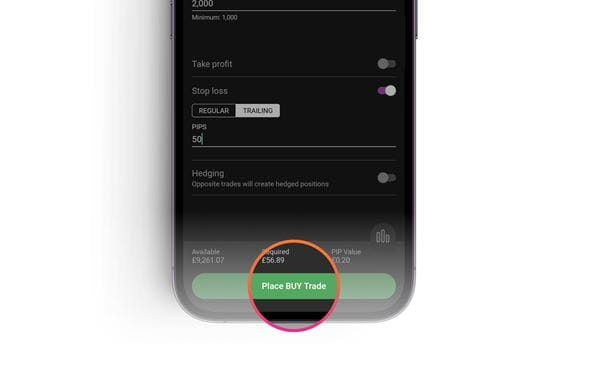
Using a trailing stop loss can be a great way to mitigate the risk of trend reversals harming your open positions. Learn about trailing stop losses, and how to use them effectively.
- What is a trailing stop loss?
- How trailing stop losses work
- Is using a trailing stop loss a good idea?
- Disadvantages of trailing stops
- When to use a trailing stop
- Trailing stop loss strategies
What is a trailing stop loss?
A trailing stop loss is a type of order you can use while trading. It works like a traditional stop order, telling your broker to close your position if it reaches it certain amount of loss. However, a trailing stop loss can move, ‘trailing’ your position as it earns a return – hence the name.
This can make trailing stops powerful tools, even enabling you to lock in profits instead of only preventing losses. However, as a sophisticated risk management tool you should fully understand how they work before getting started.
How trailing stop losses work
Trailing stop losses work by following your position if it earns a profit, but locking in and staying put if it begins to reverse. So, if your market moves in your chosen direction, the stop will move in that direction too. But if sentiment switches and the market moves against you, the stop will still close your position.
You set a trailing stop loss a certain number of points away from the current market price. This is the maximum loss on your position (without slippage), and if the market moves this number of points against you the stop will execute, and your trade will close.
So far, this is exactly the same as a traditional stop. But the difference is if your market moves in your chosen direction instead. Once it has moved up by the number of points you set, the stop will follow – initially to the level at which you opened your position, then again every time your market moves up by your set number of points.
Trailing stop loss example
Say, for instance, that you open a new sell position on EUR/USD at 1.0825, with a trailing stop 20 points away.
If EUR/USD rises to 1.0845, incurring 20 points of loss, your stop will execute and your position will be closed. But if it falls to 1.0805 instead, your stop will move down to 1.0825 – the level at which you opened your trade.
And if Eurodollar falls further, to 1.0785, then your stop will move to 1.0805. Now, if the stop is executed you’ll still earn 20 points of profit. In theory, this can continue indefinitely, enabling you to capture large parts of trends without risking a reversal wiping out all your gains.
Start trading with trailing stops
Follow these steps to practise trading with trailing stops with a City Index demo account:
- Open your City Index trading demo. It’s completely free and takes seconds
- Choose what to trade from our full range of markets
- Open the deal ticket to see live pricing, and decide whether to buy or sell
- Select the drop down next to the Stop Loss setting, and select ‘Trailing Stop’
- Decide how many points of loss to risk
- Execute your order
Then, when you’re ready, you can upgrade to a live trading account to start risking real capital.
Is a trailing stop loss a good idea?
Using a trailing stop loss can be a very good idea. As we’ve seen, they have some useful advantages over standard stops – chiefly that they allow for a passive risk management strategy that still reacts to price action.
However, trailing stops are only one tool in your risk management arsenal. And there are a few reasons why it doesn’t make sense to use them all the time.
Disadvantages of the trailing stop loss
While trailing stops can be extremely useful, they do come with some downsides:
- You can ‘guarantee’ a standard stop loss to ensure that it won’t suffer slippage – when a market moves beyond your stop so quickly that it can’t be executed at your desired level – but not a trailing stop
- Trailing stops can encourage a ‘set and forget’ mindset, which is rarely recommended when trading active markets
- They can close positions early, instead of giving them room to breathe
Let’s take a closer look at that last point by returning to our example above. What if EUR/USD had fallen to 1.0800, risen to 1.0830, and then fallen to 1.765? The trailing stop would’ve closed your position where you opened it at 1.0825. A standard stop would mean your position is still open – and 60 points in profit.
All this means that you have to pay attention to when you should use a trailing stop, and when you do use one be careful about where to place it.
When to use a trailing stop loss order
Trailing stops work best in highly trending markets that don’t see too many strong corrections – as these are most likely to trigger your trailing stop early and close your position. Markets with high volatility in both directions or rangebound conditions may be less suited to a trailing stop-loss order.
That doesn’t mean you’re limited to which asset classes you can trade. You can use trailing stops on forex, indices, shares, commodities and more.
Best trailing stop-loss strategy
When it comes to where to place your trailing stop loss order, the key is to give your position room to breathe without taking on too much risk. Continuing our EUR/USD example, a trailing stop loss set 30 points away would’ve kept your position open even if the market rises back to 1.0830.
That does, however, mean taking on 30 points of risk at the outset of your trade – which might not fit your trading plan. So how do you find the right balance? Here are two popular methods.
Using the ATR indicator
You can use your market’s average true range (ATR) to derive a set number of points to place your stop from the current price.
The average true range indicator is used as a gauge of how much a market might move in any given session. If a market has an ATR of 40, then you might expect it to move around 40 points in the next period.
This can be useful information when deciding where to place your trailing stop. If a market might move 40 points, for example, then a trailing stop 5 points away could be quickly executed. However, it is worth remembering that the ATR is a constantly changing figure, so the reading you take at the beginning of a trade might not hold true days or weeks later.
Adapting your trailing stop
One slightly more advanced technique is to adapt your trailing stop to changing market conditions. You might, for example, set it near a previous level of support or resistance initially, to close your position if the trade fails. Then, if a trend forms, you could give the position more room to breathe – especially if you’ve already ensured that you won’t lose out if your stop is triggered.
Finally, you might consider moving the stop closer once again as the trend nears its end, closing your position as soon as a reversal hits.
This strategy can even work well in combination with the ATR indicator. As the ATR updates to changing market conditions, you can adapt your trailing stop, too – taking a more active approach.
Trailing stop loss FAQs
How do I place a trailing stop on the City Index web platform?
To place a stop on the City Index web trading platform, follow these steps:
- Log in and open the deal ticket for the market you wish to trade
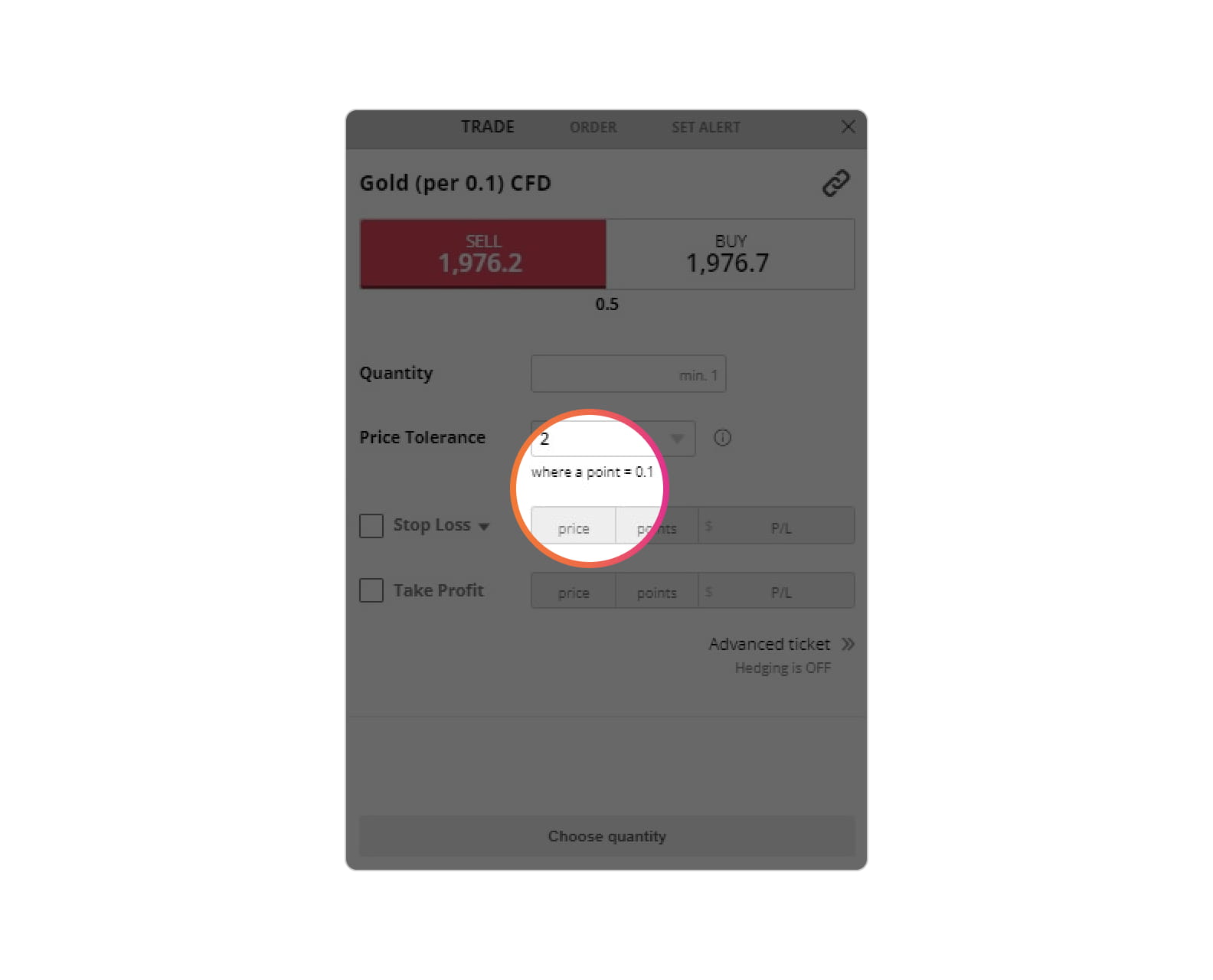
- Choose whether to go long or short, and set your deal size
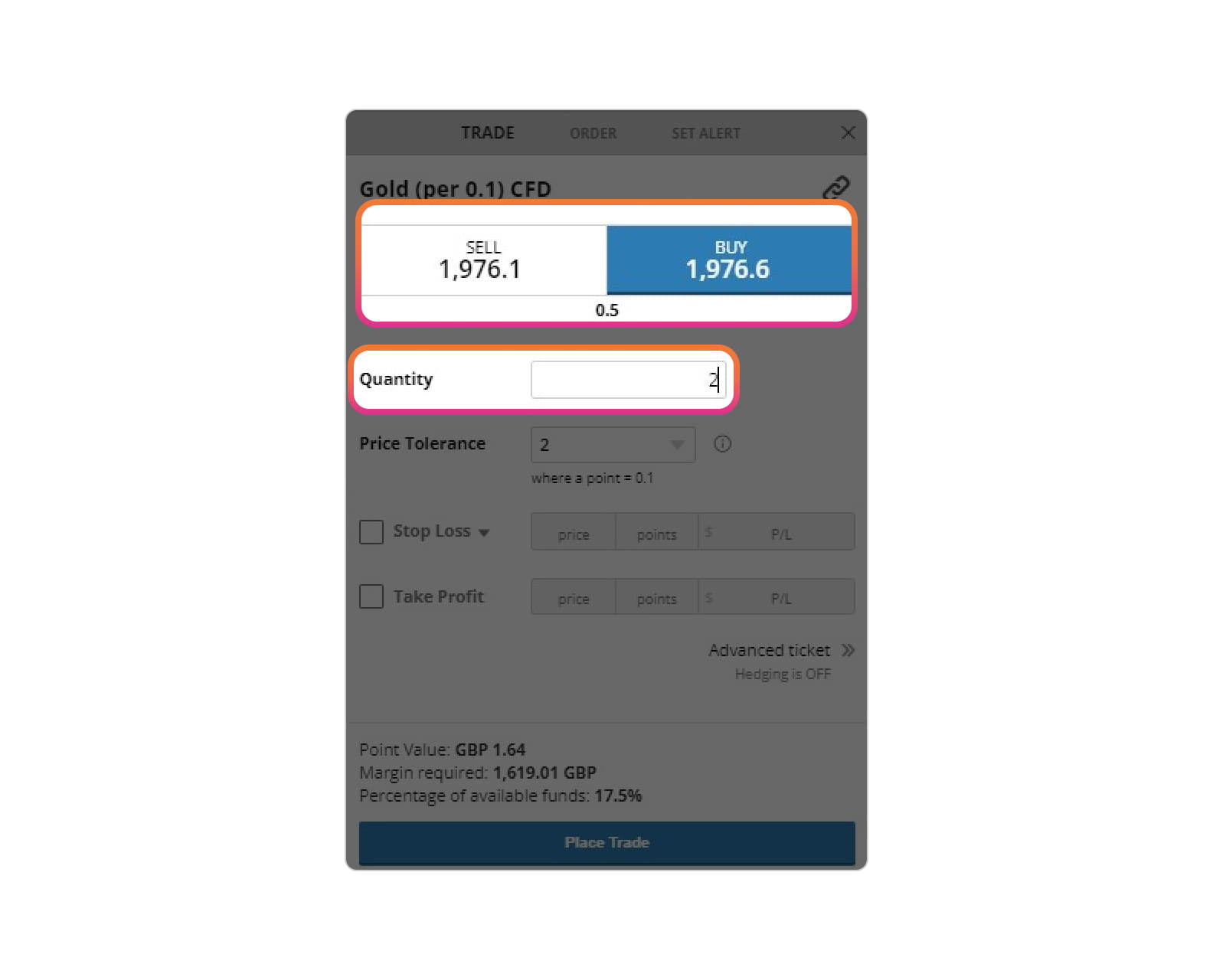
- Click the dropdown next to ‘Stop Loss’, and select ‘Trailing’
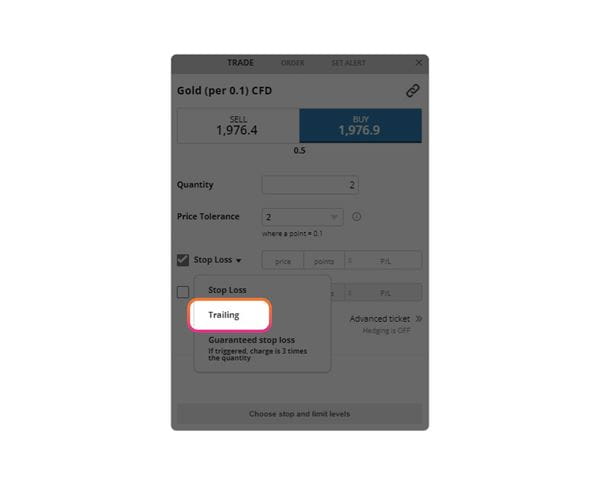
- Set how far from the live price you’d like your stop to be
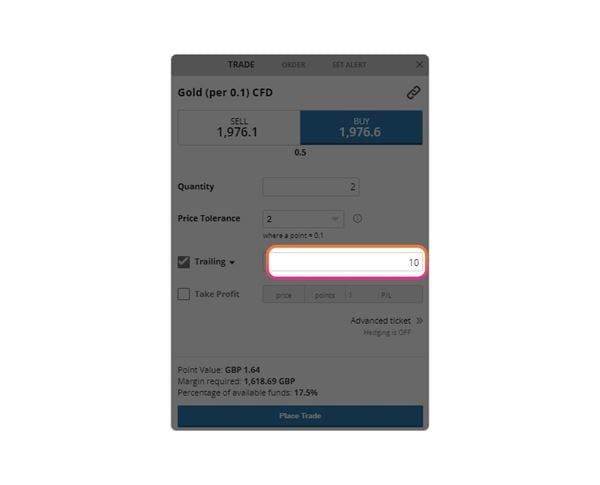
- Execute your order
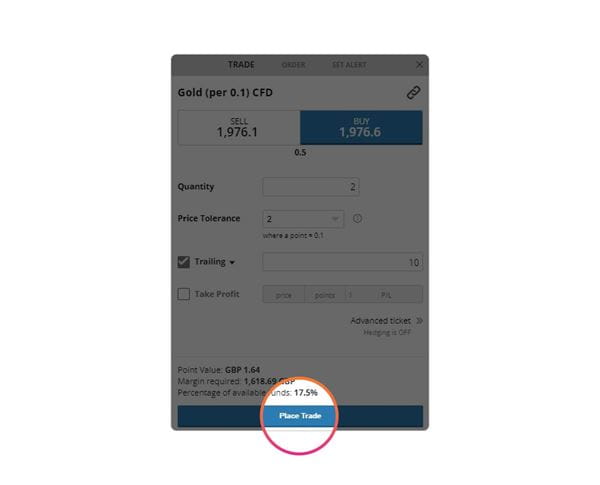
How do I place a trailing stop on the City Index mobile app?
To place a stop on the City Index mobile trading app, follow these steps:
- Log in and open the deal ticket for the market you wish to trade
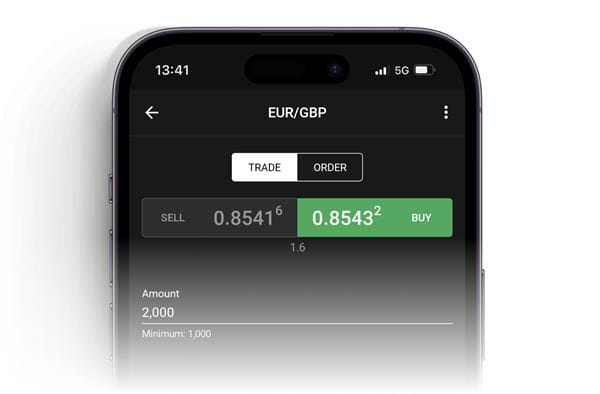
- Choose whether to go long or short, and set your deal size
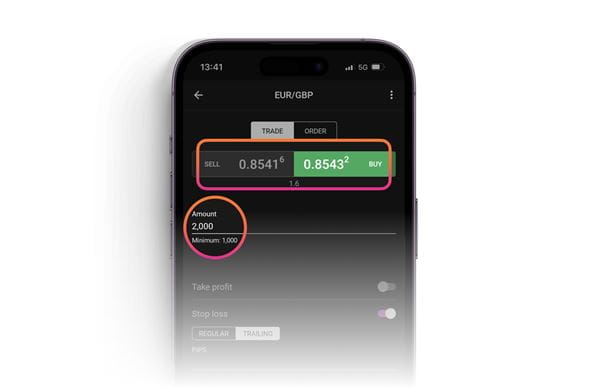
- Tap the toggle next to ‘Stop Loss’, and select ‘Trailing’
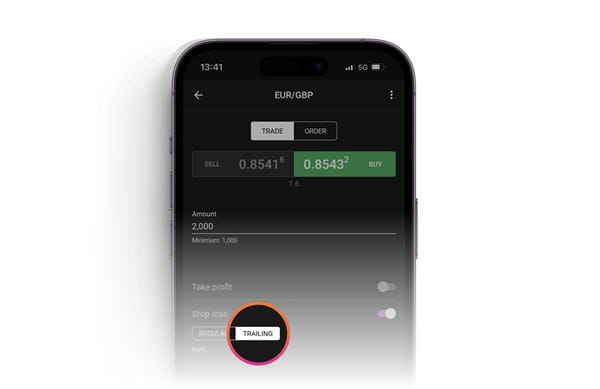
- Set how far from the live price you’d like your stop to be
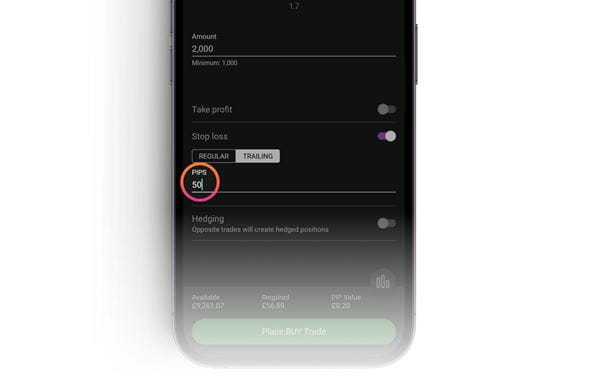
- Execute your trade
